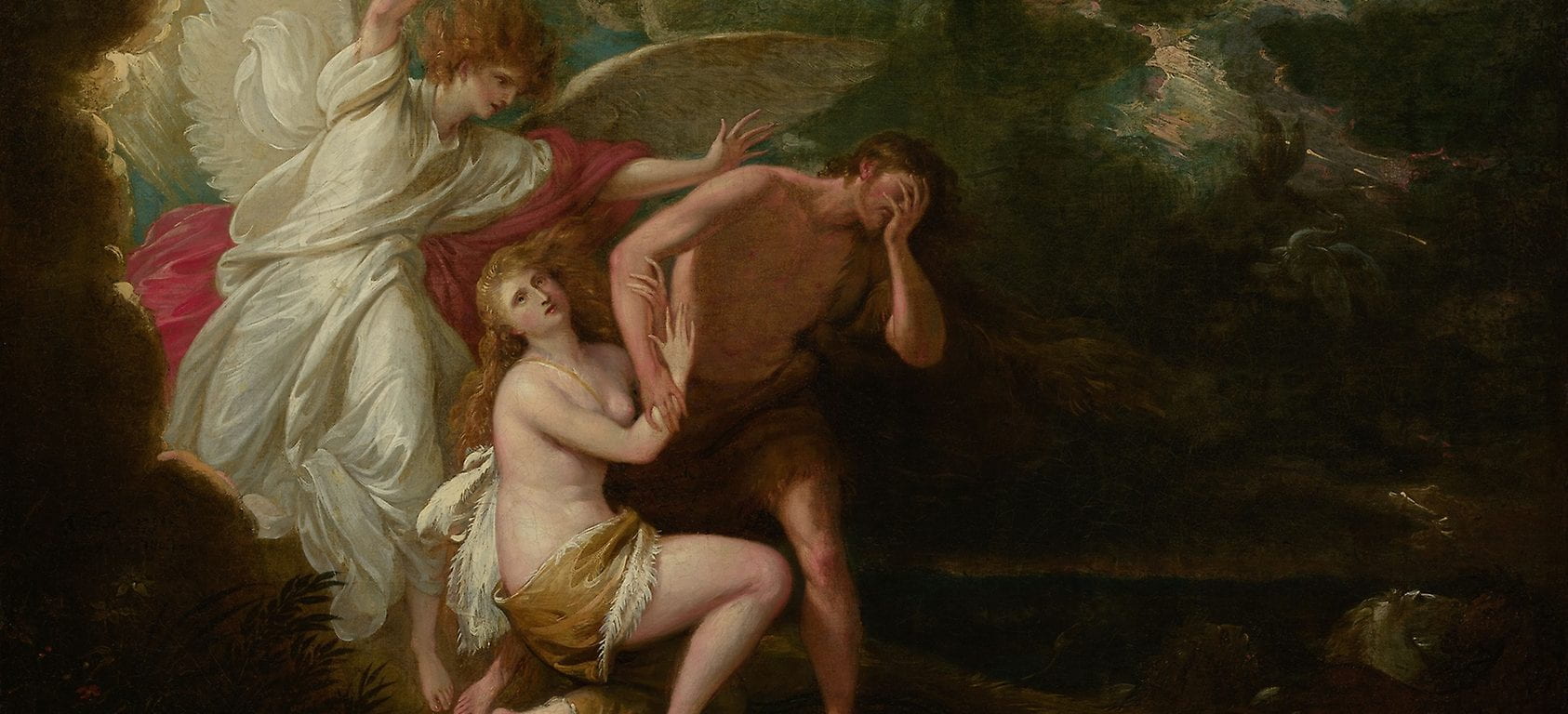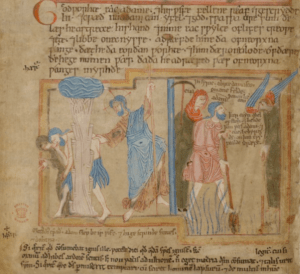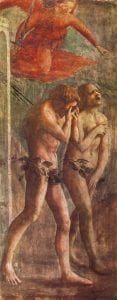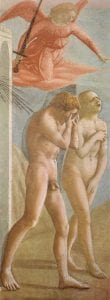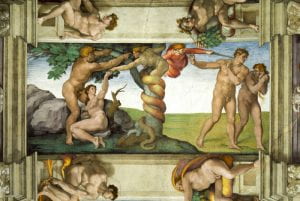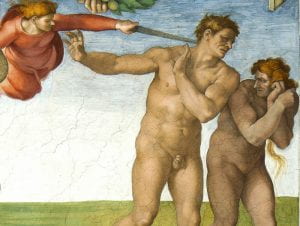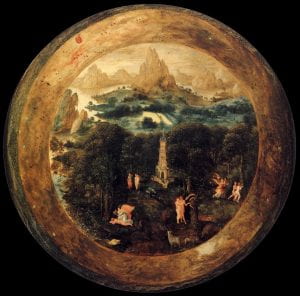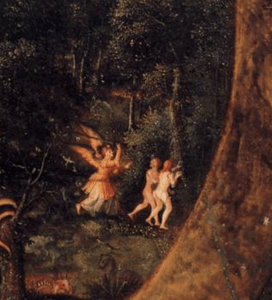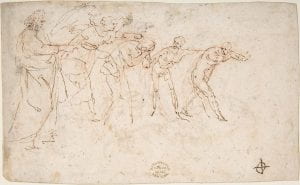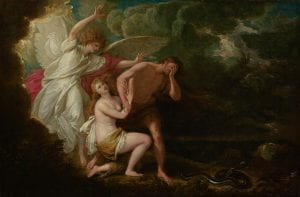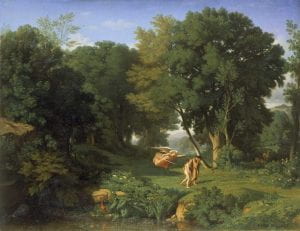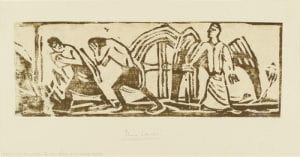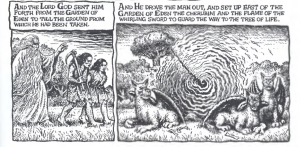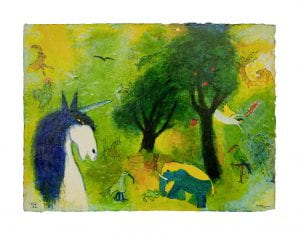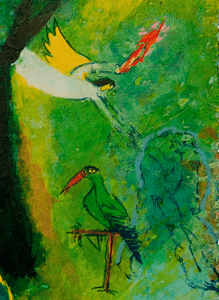As society evolves so do the ways in which we convey different imagery. In this post, I tracked artwork depicting “The Expulsion,” from the year 1000 AD all the way to 2012.
Overview:
Disclaimer: I think many of the images in this post turned out to be smaller than I anticipated. I do recommend looking at the large, higher quality versions of each image (just click on it).
I provided short statements about my opinions on each piece, and obviously there are many different ways to interpret them. In viewing these images, I got a sense of how society has come to accept the story of Adam and Eve and I found this to be a very enjoyable experience. I know this post is late, but I hope you guys will take the time to appreciate this progression as much as I have. I also feel as though comparing the similarities and differences between these works is a great activity to get in tune with the thread that has tied, and continues to tie, humanity together over the centuries of existence.
I have analyzed each of the following depictions of “The Expulsion” in light of the version of Genesis we read (Genesis B) and the original Vulgate version of Genesis; I think that it is notable that nearly none of them hold true to the textual depictions of the Expulsion. I was surprised to find that the more modern depictions hold truer to the textual representation of The Expulsion.
Relevant Background Information:
There are a few constants depicted within these images that I became curious about.
One thing you may notice, is that in all of the colored depictions, the Cherubim that expels Adam and Eve from the garden is presented in a red or partially red garment. In reading parts of the Glossary of Ecclesiastical Ornament and Costume, Compiled from Ancient Authorities and Examples by Pugin I discovered that “Cherubim signifies…’ burning,’ i. e. with Divine Love.”
And that “Cherubim are frequently represented of a bright red colour, to set forth the intensity of Divine Love.”
Also, what I found extremely interesting is that only four of the eleven depictions hold true to the textual representation of the expulsion. Adam and Eve were clothed before they were expelled from the Garden of Eden, yet, in all but four, Adam and Eve are shown naked or covering themselves with leaves. In the Vulgate version of Genesis it says, “And the Lord God made for Adam and his wife, garments of skins, and clothed them.” (Book of Genesis, Chapter 3, line 22) and in the version of Genesis we read it states, “The guardian of glory, our creator, then dressed them in garments; the Lord commanded them to cover their shame with the first clothes” (OTN, lines 940-943). In both of these versions, Adam and Eve receive clothing before they leave. This may have been an artistic choice in order to make the images more provoking and dramatic, but I did find it very interesting.
Also, the fact that in almost every figure, the Cherubim is the one who expels Adam and Eve is an important feature to dwell on. In the Vulgate version of the Bible, it states that God expelled them directly; “he cast out Adam; and placed before the paradise of pleasure Cherubim, and a flaming sword, turning every way, to keep the way of the tree of life.” (Genesis, Chapter 3, line 24). I think in the many renditions God is not directly depicted and the Cherubim takes his place as the expeller because trying to create an image of God is very difficult and any flaws could lead to punishment or shaming of the artist. The conservation of the gesture of covering the face is also very apparent in most of the works. As we’ve discussed in lecture this gesture seems to signify shame and the postlapsarian consequences of expanded vision.
Figure 1: Adam and Eve hiding from God; the Expulsion; Adam and Eve laboring – Old English Illustrated Hexateuch, London, British Library, Cotton Claudius B. iv, fol. 7v, 1000 AD
This is one of the four images that holds true to the textual depiction of the Expulsion. This may be because it is a drawing accompanying the text, so the reader will quickly become aware of any misrepresentations. The image also lacks the Cherubim, and God expels Adam and Eve himself. I think this is an interesting facet to focus on, in later works as well, because by depicting God expelling Adam and Eve himself, the artist has to depict God. This is something that is a very difficult thing to do because God differs for many.
Figure 2: Masaccio, Expulsion for the Garden of Eden, 1426-27, fresco, Brancacci Chapel, Florence, Italy
The image on the left is prior to the recent renovation of the fresco. The leaves on the image on the left were not part of the original and were added during the 17th century.
The depiction the Masaccio provided us is not entirely accurate to the actual retelling of Genesis in either the Vulgate or Genesis B. This was one of the first depictions of the expulsion. I found two quotes in the version of Genesis that we read, that I thought could maybe help describe Adam and Eve’s gestures. After eating the fruit, before God arrived, Adam guilts Eve and states, “so now I can regret forever after that I laid eyes on you” (OTN, pg 63, line 819-820). This could help explain that he not only covers his face in shame, but also to not see Eve to worsen the disappointment and anger he holds towards her. In response to Adam, Eve says, “you cannot regret it worse in your mind than I do in my heart.” (OTN, pg.63 line 826). This might be somewhat of a stretch, but it could reveal that she is not only using her arm to cover her breasts, but to also feel her grieving heart.
Figure 3: Michelangelo Buonarroti, Expulsion from Garden of Eden, 1509-10, fresco, 280 x 570 cm, Cappella Sistina, Vatican
What I find interesting about Michelangelo’s depiction of “The Expulsion” is the placement of both Adam and Eve’s hands and gazes. Adam keeps his eyes shut rather than covering his face with his hands. Instead, his hands almost seem as if they are grasping blindly for something (maybe for the prelapsarian blindness? Which gives reason to why he grasps at the mere air). It’s also somewhat strange that he seems as though he is trying to prevent seeing the Cherubim and the Garden of Eden, although it is the one place where there is no evil. He also seems as if he is trying to prevent their expulsion, which is unique to this piece. Eve, on the other hand, has no problem viewing what Adam prevents himself from seeing. Maybe because she’s held the ability of sight for longer that she has become keener on how to utilize it? To me, it appears that Eve is depicted in a very masculine way. Her facial features and body seem to almost mirror those of Adam. Could this somehow relate back to how they were children within Eden? Here, the Cherubim also lacks wings, yet still has the ability to fly.
Figure 4: Herri met de Bles, Paradise, circa 1545, oil on walnut panel
I thought this one would be fun to include since it’s on a different medium (walnut panel). It’s also interesting how the Cherubim chases Adam and Eve out of the Garden, almost as if she would cause them harm if they did not leave immediately. Adam and Eve are also reach forward, but their gazes fixate on the angel. It’s hard to tell, but it doesn’t seem like there’s much shame. This is the only picture where Eve’s face is not shown.
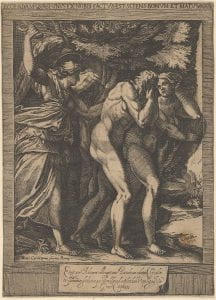
This works ties a lot of the pieces together. We see Adam’s look of shame represented. We are also exposed to what the Garden of Eden may look like. I also like how the rocks create somewhat of a natural archway to the garden. I’ve seen other representations where the entrance was represented by a gold pleated gate, which I personally dislike. It almost looks as if Eve is mocking the Cherubim by the way her hand is placed. Aesthetically, I like how all three of the figures within this engraving were aligned with each other. I think this makes it so the eyes focus more on what’s happening in the upper half on the engraving rather than distracting from it.
Figure 6: Francesco Allegrini, The Expulsion of Adam and Eve from Paradise, Pen and brown ink, over red chalk, 1624–63
I especially like this depiction of the Expulsion because it merits some creativity to the viewer. It’s easy to make out God and the Cherubim but it’s kind of difficult to tell who is Adam and who is Eve (although I think Eve may be out front?). I’m confused as to what the almost skeletal figure represents. Here we see that Adam and Eve both shield their eyes as to what lies ahead. This sketch also somewhat reminds me of the image of the
Figure 7: Benjamin West, The Expulsion of Adam and Eve from Paradise, oil on canvas, 1791
This is the only image to include the serpent, which I rather like. It serves as a reminder of their sin in a way and is almost mocking them. The fact that the serpent is drawn towards the darkness (the direction Adam and Eve also must go) reveals the terrible things that lie ahead. I also like how it depicts darkness and a rather ominous landscape, which would hold truer to what Adam and Eve were actually experiencing. West gives us the eyes of Adam and Eve in a way, their postlapsarian vision. It also seems like Eve is almost pleading with the Cherubim, who pays no attention to her. Here we also see the gesture of shame in Adam. To me personally this is the most powerful depiction of the Expulsion.
Figure 8: Jean-Achille Benouville, Adam et Ève chassés du Paradis terrestre (Adam and Eve Chased from the Terrestrial Paradise, oil on canvas, 1841
I like this one a lot because it so meticulously depicts the Garden of Eden, and its luscious landscape. If you look in the tree though, you can see the serpent winding up its trunk, thus staying within the Garden. Eve’s posture is kind of strange. She doesn’t really look like she’s grieving and rather looks a little disappointed. Here, the Cherubim is a male rather than a female.
Figure 9: Rohlfs, Christian, graphic, “Austreibung aus dem Paradies” (Expulsion from paradise), woodcut, 12.6 x 35.5 cm, Germany, 1915-16
This is the most accurate portrayal of the Expulsion. Adam and Eve are clothed, and the Cherubim guards the entrance of the Garden of Eden, it doesn’t chase them out. Adam and Eve also visibly grieve. It seems as though Adam seems as if he is pleading/ trying to evoke sympathy from the Cherubim, without luck.
Figure 10: Robert Crumb, The Book of Genesis, 2009
Although a unique, and most likely not the first way in which people visualize the expulsion, Robert Crumb’s rendition holds the truest to the biblical narrative and is the only picture to incorporate written language. It is not only text, yet a direct quote from the vulgate version of Genesis. I find that by doing this Crumb increases the ethos of his rendition. He shows his audience what he reaps from the words of the Bible—how he visualizes the word of the Lord. Crumb also adds a humorous note with the Cherubim (dogs with wings rather than the common gowned human figure as seen in all of the other pictures. I also think it’s interesting to note that instead of the Cherubim chasing Adam and Eve from the garden, God does so himself. Although all of the other images depict the Cherubim This establishes a more direct connection to God. Yet, I feel as though this not the best approach because Crumb actually depicts God as a very human like figure. The other to highlight the idea that God is not something/someone that can be visualized/ perceived by the human eye. Yes, I do feel as if Crumb’s depiction is more casual than the other pieces (because it didn’t shape humanity and hasn’t been in a chapel for a few hundred years) yet even in the modern day I think we still hold the responsibility to both respect the past ideas I think Crumb does do a good job at connecting the modern reader with Genesis since with the rise in atheism, much of society has become disconnected from these stories and the graphic novel format makes them more accessible and less formidable.
Figure 11: Adi Holzer, Garten Eden, Acrylic on serigraphy, 2012
I decided to include this piece to show how much depictions have evolved from the first image that was made in 1000 AD. It is definitely a more abstract representation. The faces of Adam and Eve are not very visible. Also, it seems like Adam does still seem to have his face in his hands. This is the only image where the cherubim holds a fiery sword, like the Bible suggests.
Informational Sources:
https://archive.org/details/cu31924020490383/page/n19/mode/2up
Anlezark, Daniel, ed. and trans. Old Testament Narratives. Dumbarton Oaks Medieval Library. Cambridge, MA: Harvard University Press, 2011.
